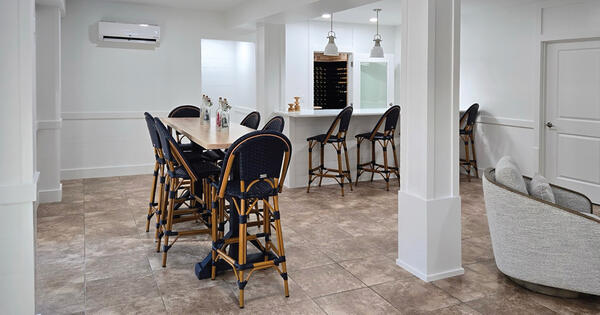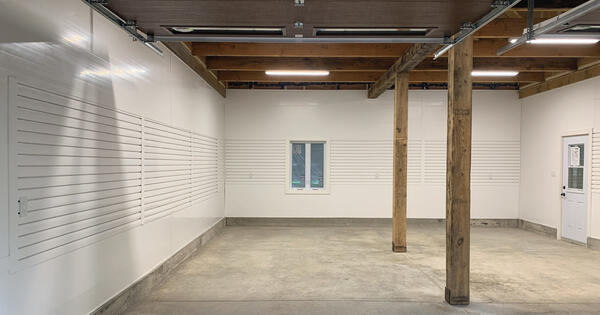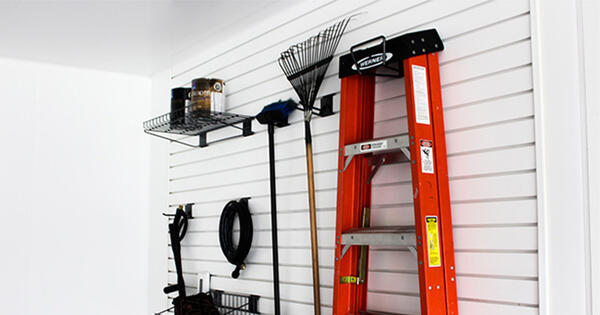Looking to upgrade your home's vibe without a major overhaul? Enter half wall paneling — an understated yet impactful design choice that can redefine the ambiance of your living spaces.
Let's dive into the world of half wall paneling and explore how this simple addition can bring a touch of architectural charm to your home.



What is Half-Wall Paneling?
Half-wall paneling refers to installing decorative panels or materials on the lower portion of a wall, covering the area from the floor to roughly halfway up the wall's height. The upper half of the wall above the paneling is typically left painted, wallpapered, or treated in a different manner than the lower portion, creating a visual contrast. This design element is commonly used in various areas of a home, such as dining rooms, hallways, entryways, or living rooms, and it can be adapted to different architectural styles and design preferences.
Benefits of Half-Wall Paneling
Picture this: improved aesthetics, added architectural interest, and a unique touch that sets your space apart. Half-wall paneling is more than just a pretty face — it's a game-changer. Think of it as wainscoting's sophisticated cousin, offering a similar vibe but with its own distinctive flair. Beyond looks, it serves practical purposes, too — defining spaces, camouflaging imperfections, and injecting character:
- Enhanced Aesthetics: Half-wall paneling adds a touch of sophistication and visual interest to a room. It can contribute to a more polished and finished look, enhancing the overall aesthetic appeal of the space.
- Defined Spaces: Half-wall paneling can be used to define different areas within a room, creating distinct zones without completely closing off the space. This is particularly useful in open-concept living areas.
- Architectural Interest: Installing half-wall paneling can introduce architectural interest to a room, giving it character and depth. The panels can be designed in various styles, such as beadboard, shiplap, or raised panels, adding texture and dimension.
- Protection for Walls: Half-wall paneling provides a protective barrier for the lower portion of walls, guarding against scuffs, scratches, and other forms of wear and tear. This is especially beneficial in high-traffic areas or homes with children and pets.
- Ease of Installation: Compared to full-wall paneling, half-wall paneling is generally easier and less time-consuming to install. This makes it a more manageable DIY project for homeowners looking to update their space without extensive construction work.
- Versatility in Design: Half-wall paneling offers a versatile design element that can complement various interior styles. It can be painted or stained in different colors to match or contrast with the existing decor, providing flexibility in design choices.
- Improved Acoustics: Depending on the material used for the panels, half-wall paneling can contribute to better acoustics in a room. It may help absorb sound and reduce echoes, creating a more comfortable and quiet environment.
- Cost-Effective: Half wall paneling is often more cost-effective than covering entire walls, making it a budget-friendly option for those looking to upgrade their space without a significant financial investment.
7 Best Materials for Half-Wall Paneling
Now, let's talk materials. From classic wood to modern PVC, each option has its perks. Wood brings warmth, MDF is budget-friendly, beadboard adds texture, shiplap delivers a coastal vibe, and PVC scores high on durability. Choose wisely based on your preferences, budget, and the level of maintenance you're comfortable with after weighing the pros and cons below.

Wood Half-Wall Paneling
Solid wood panels, such as oak, pine, or maple, are commonly used for half-wall paneling.
Pros:
- Natural Aesthetics: Wood paneling offers a warm and authentic appearance, bringing a natural element to the space.
- Durable: Solid wood panels are generally durable and can withstand wear and tear over time.
- Versatility: Wood can be stained or painted in various colors, providing versatility to match different design styles.
- Customization: Wood panels can be easily customized in terms of size, shape, and detailing to suit specific design preferences.
- Timeless Appeal: Wood has a classic and timeless appeal that can enhance the overall aesthetic of a room.
Cons:
- Cost: Solid wood paneling can be expensive compared to other materials, making it a less budget-friendly option.
- Maintenance: Wood requires regular maintenance, including sealing or varnishing, to protect it from moisture and prevent warping or rot.
- Susceptibility to Moisture: Wood is susceptible to moisture, and prolonged exposure can lead to swelling, warping, or mold growth.
- Environmental Impact: Depending on the source, the production of wood panels may contribute to deforestation and environmental concerns.
- Installation Complexity: Installing wood paneling may require more skill and effort, especially for achieving a seamless and professional look.

PVC Half-Wall Paneling
PVC panels like Trusscore Wall&CeilingBoard are made from a plastic material known as polyvinyl chloride and are ideal for homeowners prioritizing performance over design from their half wall panels.
Pros:
- Moisture Resistance: Trusscore Wall&CeilingBoard is 100% moisture and water resistant and will never grow mold or mildew, making it suitable for areas prone to humidity like bathrooms and kitchens.
- Low Maintenance: Trusscore Wall&CeilingBoard panels are easy to clean and require minimal maintenance, as they can be wiped down with a damp cloth and standard household cleaners.
- Lightweight: Trusscore Wall&CeilingBoard is lightweight, making it easier to handle and install compared to some heavier options like wood.
- Durable: Trusscore Wall&CeilingBoard is a durable material that’s scratch, dent, and damage resistant. It’s also resistant to rot, corrosion, and insects.
- Cost-Effective: PVC is often more cost-effective than natural materials like wood, making it a more budget-friendly option.
Cons:
- Limited Warmth: PVC may lack the natural warmth and authenticity of materials like wood, which can be a drawback for those seeking a more organic look.
- Limited Color Options: Trusscore Wall&CeilingBoard is only available in white and gray, which can potentially restrict your design choices.
- Limited Insulation Properties: PVC has limited insulation properties, so it may not contribute significantly to the insulation of a space.

MDF Half-Wall Paneling
Medium-density fiberboard (MDF) is an engineered wood product made from wood fibers and resin compressed into dense sheets.
Pros:
- Smooth Surface: MDF provides a smooth and uniform surface, creating a sleek and modern appearance.
- Cost-Effective: MDF is generally more affordable than solid wood, making it a budget-friendly option for paneling.
- Resistant to Warping: MDF is less prone to warping, cracking, or splitting compared to solid wood, providing stability over time.
- Paintable: MDF accepts paint well and can be finished in a variety of colors and finishes to match different interior styles.
- Consistent Quality: MDF panels have consistent density and quality, ensuring uniformity in appearance and performance.
Cons:
- Susceptibility to Moisture: MDF is sensitive to moisture and can swell or become damaged if exposed to high humidity or water.
- Not as Durable as Solid Wood: While less prone to some issues like warping, MDF is generally not as durable as solid wood and may be more susceptible to damage.
- Formaldehyde Emissions: Some MDF products may emit formaldehyde, a potential indoor air pollutant. Look for low-emission or formaldehyde-free options if air quality is a concern.
- Limited Weight-Bearing Capacity: MDF has a lower weight-bearing capacity compared to solid wood, so it may not be suitable for applications where structural strength is important.
- Edge Sealing Required: The edges of MDF panels need to be sealed properly to prevent moisture absorption, and special care is required to avoid damage during installation.

Plywood Half-Wall Paneling
Plywood consists of layers of wood veneer glued together, offering strength and stability. Plywood consists of layers of wood veneer glued together, offering strength and stability.
Pros:
- Affordability: Plywood is generally more affordable than solid wood, offering a cost-effective option for wall paneling.
- Versatility: Plywood is available in different thicknesses and can be cut into various shapes and sizes, allowing for customization.
- Resistance to Warping: Plywood is less prone to warping compared to solid wood, providing a more stable surface.
- Availability: Plywood is readily available in a variety of grades, making it easy to find the right type for your project.
Cons:
- Visible Seams: Depending on the size of the panels and the grade of plywood used, visible seams may be present, affecting the overall appearance.
- Aesthetic Limitations: While plywood can be finished in various ways, it may not offer the same aesthetic richness as solid wood.
- Moisture Sensitivity: While less prone to warping than solid wood, plywood can still be affected by moisture and humidity, requiring proper sealing.
- Environmental Impact: The production of plywood involves adhesives and chemicals, contributing to environmental concerns.
- Uniformity Challenges: Lower-grade plywood may exhibit variations in color and grain patterns, affecting the overall uniformity of the wall paneling.
- Edge Sealing Required: Like other wood-based materials, plywood requires proper edge sealing to prevent moisture absorption.

Beadboard Half-Wall Paneling
Beadboard features narrow, vertical planks with a distinctive groove or "bead" between each plank.
Pros:
- Textured Appearance: Beadboard features a distinctive design with narrow vertical planks and a groove or "bead" between each plank, adding texture and visual interest.
- Classic and Timeless: Beadboard has a timeless and traditional look, making it suitable for various interior styles, from cottage to farmhouse.
- Versatility: Beadboard is versatile and can be used in different areas of the home, such as kitchens, bathrooms, or bedrooms.
- Easy Installation: Beadboard is relatively easy to install, especially in comparison to more complex paneling options.
- Durable: Beadboard is typically made of solid wood or MDF, providing durability and resistance to wear and tear.
Cons:
- Visible Seams: Depending on the size of the panels, visible seams may be present, impacting the overall aesthetic.
- Limited Design Options: While classic, the design of beadboard may be considered limiting for those seeking a more contemporary or modern look.
- Moisture Sensitivity: If made of wood, beadboard can be sensitive to moisture, requiring proper sealing in areas prone to humidity or splashes.
- Maintenance: The grooves in beadboard may require extra attention during cleaning, as dust and dirt can accumulate in the recessed areas.
- May Not Suit All Styles: The traditional look of beadboard may not be suitable for all design styles, limiting its application in certain modern or minimalist interiors.

Shiplap Half-Wall Paneling
Shiplap consists of horizontally overlapping boards with a rabbet joint.
Pros:
- Rustic and Trendy Aesthetics: Shiplap has a distinctive and rustic appearance that adds character to a space, and it has become a popular and trendy design choice.
- Easy to Install: Shiplap is relatively easy to install, featuring overlapping boards with a rabbet joint, creating a seamless and cohesive look.
- Versatility: Shiplap can be used in various settings, from traditional to contemporary, making it a versatile choice for different interior styles.
- Textural Interest: The horizontal lines and grooves of shiplap provide textural interest to walls, contributing to a visually appealing design.
- Paintable: Shiplap can be painted in a variety of colors, allowing for customization to match the overall color scheme of a room.
- Wainscoting Application: Shiplap is often used in wainscoting applications, adding a decorative element to the lower portion of walls.
Cons:
- Dust Accumulation: The horizontal grooves of shiplap may accumulate dust and dirt, requiring regular cleaning to maintain a fresh appearance.
- May Not Suit All Styles: While versatile, the rustic and casual look of shiplap may not be suitable for all design styles, particularly in more formal or modern settings.
- Gaps Between Boards: Shiplap features gaps between boards, and these gaps may allow sound to travel through and may require additional insulation for sound control.
- Not Ideal for Moist Areas: Shiplap made of wood may not be suitable for areas prone to moisture, such as bathrooms, without proper sealing and maintenance.
- Installation Challenges: Achieving a seamless and professional look during installation may require precision and attention to detail, particularly in the alignment of the boards.

Wainscoting Instead of Half-Wall Paneling
Half wall paneling refers to decorative panels that cover the lower half of a wall, while wainscoting is a specific type of paneling that extends up to a predetermined height on the lower part of the wall, often encompassing chair rail height or one-third of the wall's total height.
If you’re torn between wainscoting and half wall paneling, here are the pros and cons to consider.
Pros:
- Architectural Interest: Wainscoting adds architectural interest and sophistication to a space, enhancing its visual appeal.
- Versatility: Any half wall panel material can create wainscoting, letting you choose from a wide variety of styles, including raised panels, beadboard, shiplap, and more.
- Wall Protection: Wainscoting provides a protective barrier for the lower portion of walls, guarding against scuffs, scratches, and other forms of wear and tear.
- Defined Spaces: Wainscoting helps define different areas within a room, creating distinct zones without completely closing off the space.
- Classic and Timeless: Wainscoting has a classic and timeless aesthetic, making it suitable for various interior styles.
Cons:
- Installation Complexity: Wainscoting installation may require professional expertise, especially for intricate styles or if a precise, custom look is desired.
- Limited Height Options: Traditional wainscoting is often installed at chair rail height or one-third of the wall's total height, which may limit design options for those seeking a different height.
- Design Commitment: Once installed, wainscoting can be challenging to change or remove without significant effort, making it a design commitment.
Ready to redefine your space? Half wall paneling offers a world of possibilities for those seeking a sophisticated yet practical home transformation. Choose your material, coordinate with your decor, and, if you're feeling adventurous, embark on a DIY project to personalize your space. Elevate your home's style effortlessly with the timeless appeal of half wall paneling. Your stylish home transformation is just a few panels away!






